At its recent meeting, the Townsville City Council endorsed a recommendation from its officers that the opening of Lake Paluma to additional recreational/commercial opportunities will not be contemplated due to its low-key, nature based recreational activities and camping focus. This decision will ensure that the dam remains closed to motorised boating and other commercial activities. This is an excellent outcome. The PDCA has previously communicated to the TCC its strong opposition to any change in the use of the Dam. Margie Ryder, our local Councillor has made our views clear to the Council. We appreciate that her efforts on our behalf have helped to achieve this outcome.
Author: admin
A Colourful visitor to the garden
Among the colourful visitors to my garden recently was this beautiful female Orchard Swallowtail Butterfly, (Papilio aegeus). This species is also known as the Large Citrus Butterfly because of the preference of its larvae for feasting on citrus leaves. The butterfly feeds on the nectar of plants, particularly lantana. This one however was resting on a flower-laden choko vine.
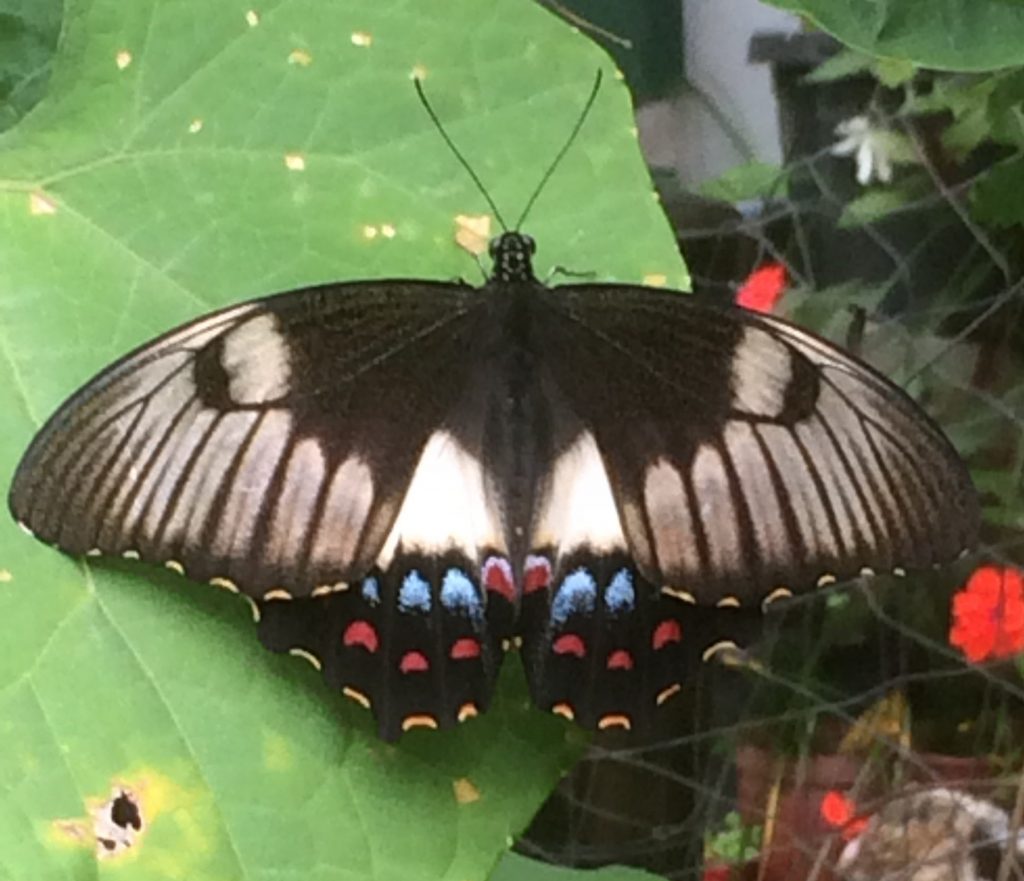
The Orchard Swallowtail Butterfly is found in Eastern Australia, ranging from Victoria to Cape York and into PNG. Its usual habitat is lowland rainforest, dry eucalypt woodlands, orchards and suburban gardens so it is not common to see one here in Paluma. The female lays eggs on the underside of leaves of host trees and the eggs hatch a week later. The larvae are patterned in green, brown and a creamy colour and look remarkably like bird droppings: no doubt an excellent camouflage from potential predators.
The female with a wing span of about 105 to 110 mm is slightly larger and more colourful than the male but both attract attention when fluttering through the garden. This butterfly is sometimes considered a pest because of its habit of feeding on citrus leaves in suburban gardens.
Text and photo by Colwyn Campbell
PDCA President’s report for 2018-19
Ever wondered what exactly the PDCA does during the year? I did before I joined the Executive Committee, but found that reading through past President’s reports was a very useful primer on how the PDCA works to improve facilities and services in the village. Several past reports can be found on our website, and I am posting my contribution to this here.
Please contact me (or add a comment) if you have any questions about what has been reported, or if you have any suggestions for what we need to concentrate on this year.
Jamie Oliver
PDCA President’s Report – 2018-19
Over the last year several important milestones have been achieved in Paluma. For each of these the insights, planning and management needed to achieve these outcomes has been the result of the efforts of many people over the course of more than just one year, including all members of the PDCA executive. I think that all Paluma residents should feel very proud of what a small community such as ours can achieve across a range of issues if we work together with a common vision.
Key outcomes for the year that I would particularly like to highlight include:
- Completion of the new Community Hall Extension. All members of the PDCA executive contributed significantly to this outcome but it is the early work of previous executive members such as John Tubman and Michael Drew that was important in designing the hall, finding funds, developing plans, and managing the building contract. Without Michael’s effort we would never have had sufficient funds to start this extension, and without his efforts in chasing up a builder who could do the work within our budget it would never have been completed. In appreciation of the efforts of John Tubman, on this and a myriad of other contributions to the PDCA, we named the extension the John Tubman Room. All members of the Executive, especially Wilfred and Lynn, also played a crucial role in identifying areas requiring attention during the constructions, thus ensuring a Room that will serve our purposes for many years to come.
- Completion of the new Water Treatment Plant. This had been a prolonged and controversial project that might never have happened without the persistence and determination of most Paluma residents to hold the council to its obligations in providing clean potable water. The quality of our water now exceeds that of Townsville and many of its suburbs.
- Opening of the High Ropes Course. It was fantastic to see the opening of the first new commercial facility at Paluma in many years. The PDCA cannot claim any responsibility for this but we have been enthusiastically supportive of the efforts and vision of Sam Stedman and Wilfred Karnoll who partnered in developing the facility. It appears to be a success with regular use by schools and other private groups
- Repair of the Hussy Rd turnoff and paving of the beginning of Hussey Rd. This has been an ongoing issue for many years but thanks to the efforts of Michael Drew and other residents of the “Republic of Hussey Road” it has now been completed.
- Installation and commissioning of the new Telstra Mobile phone tower. This has had a major impact on our community, providing high quality digital and voice communication throughout the village and out to Hussey Road. The ground work for this project was laid by several previous PDCA executive members.
- Construction of a new Website – Paluma.org. We now have a highly functional website that provides information on the attractions and history of Paluma. It also allows regular contributions from our prolific nature and social bloggers (Colwyn Campbell and Michele Bird) as well as other residents. A review of website usage indicates that we get about 350 visits per month. Most of this traffic is directed at the various posts, but we have also had more than 1000 downloads of documents from the Maps and History sections of our library. Currently the website has of 54 pages of information (separate from regular posts) and more than 200 photographs that can be displayed in slideshows or used for illustrative purposes.
In addition to these major milestones, the PDCA has also continued to carry or promote our annual program of social, cultural and sporting activities. These include:
- Paluma Push – our role was to provide assistance at check points and hold a end of event BBQ for all volunteers
- Paluma Races –provided a venue for the start, assistance with promotion, logistics and checkpoints
- Our regular Social Nights organized by Lynn and Les Hyland with help from many others
- Garden Competition
- Bush Dance with Wattle and Gum
- Sunday Markets
Lynn continued to do a fantastic job managing hall bookings this past year. We have attracted a number of interesting groups up to Paluma (Blankets of Love, Buddhist Retreat, Plant Identification course) and this not only helps to enhance our visibility as a great place to hold workshops or retreats, but also continues to make an important financial contribution to the Association.
In addition to the construction of the new Hall extension, the Paluma Community Centre Management Committee (SES, PDCA, PRFS) has reviewed the need for major maintenance of the rest of the building and has arranged for the existing roof to be re-screwed, gutter brackets replaced and new skylights installed. Further maintenance and improvement works such as a covered walkway between the back SES door and the back stairs to the new Hall extension, and the installation of a concrete slab under the hall for a generator, is being planned for this year.
The PDCA spent some time looking at safety issues this year. We held meetings with Transport and Main Roads to discuss the need for upgrades of the range road at several spots and have been informed that efforts will be made to include this work in the next bid for road funding in 2019-20. The PDCA has had several discussions with relevant authorities about speeding in the village and we will continue to lobby for appropriate signage and other realistic measures to make are village roads safer. We have also reviewed arrangements for the location of the Royal Flying Doctor Service kits. It will remain at the Ivy Cottage with Ian Marshall acting as the key contact person. We have also investigated options for access to a defibrillator. Currently there is a defib (currently being serviced) in the Paluma Fire Brigade vehicle, and Michael Drew has arranged for a second unit (in service) to be made available over the Easter weekend in the Hall. To cater for other injuries, Juanita Poletto has organized the placement of a St John’s Ambulance first aid kit (with additional kits for burns and snake bites) in the hall, together with appropriate signage.
Building on the capabilities of our new website, we have undertaken a major revision of the format for Turkey Talk. Given that our web posts now cover over 90% of traditional Turkey Talk content, the newsletter is now circulated as a quarterly digest of new information posted to the Website.
Although the PDCA has accomplished quite a bit during the year, we still have a list of issues and jobs that we started to address but have not reached full completion or resolution. Some of our priorities for next year include:
- Finalize discussion with TMR on road closure policies during and after road slips, vegetation clearance schedules, and on funding for a major works program to address safety hotspots on the road
- Construction of a platform and interpretive signage for the Star Valley Lookout
- Development of new garden beds along the main roads of the village
- Construction of a walkway with Platypus viewing platforms
Jamie Oliver
PDCA President
PDCA Executive Committee for 2019-20
At the recent PDCA Annual General Meeting the following people were elected:
| President | Jamie Oliver |
| 1st Vice President | Sarah Swan |
| Treasurer | Wilfred Karnoll |
| Secretary | Michele Bird |
| Committee Member | Lynn Hyland |
We welcome Sarah as a new member to the Committee (and to Paluma) and look forward to her contributions and perspectives on how we can ensure Paluma lives up to, and enhances, its reputation as a key destination for locals and interstate/overseas visitors, and as a small patch of paradise for those of us who are residents.
The position of 2nd Vice President is currently vacant (it is an optional position) but we are keen to fill it if there is someone who is interested in getting involved with the PDCA. Please contact Michele or anyone above it you would like further information.
Colwyn Campbell and Juanita Poletto decided not to seek re-election this year in order to concentrate on other work. The meeting thanked both outgoing members for their contributions on the Committee. Colwyn in particular has been on the committee as Vice President or Treasurer. Her calm and considered voice on key matters during Exec meetings will be missed. Colwyn will continue to play a key role in the History Project as well as maintaining her important contributions to the Web site and Turkey Talk (as editor). Juanita was also thanked for her work in securing new first aid kits for the hall and in conducting a review of the Royal Flying Doctor medical kit arrangements (which remains at Ivy Cottage under the stewardship of Ian Marshall).
The full minutes of the AGM and General Meeting will be published shortly in the members section of the website.
Close Encounters with a Serpent
Red-bellied Black Snake (Pseudechis porphyriacus)
Some recent, and unexpected encounters with Red-bellied (or Common) Black Snakes have prompted me (Colwyn Campbell) to write this article about the slithery reptile. I regularly meet these creatures in my garden and whilst out walking. My most recent encounter was last week at 7.30 in the morning after a night of heavy rain.
I was sweeping leaves off the front veranda and had left the door open so that Flossie (my dog) could follow me out. Becoming aware of activity behind me I turned to see, between me and the door, Flossie engaged in a vigorous pas de deux with a very large red-bellied black snake. Without thinking, I used the broom to drag Flossie close enough to grab her by the collar and throw her inside the house, while at the same time trying to fend off the snake and foil its apparent intention of entering the house. I then leapt inside and slammed the door. Poor thing – it probably only needed a warm, dry place to escape from the cold and rain-sodden garden. But I didn’t want it inside my house! I watched it coil up near my firewood box, then promptly rang my neighbour (Len Cook) who sent the snake on its way by turning the hose on it. This is the largest red-bellied black snake I have seen in my area so naturally, I am concerned that Flossie does not meet up with it again.
The red-bellied black snake is so much part of the Paluma rainforest environment that most of us take its presence for granted. Gardeners know to make a few thrusts with a rake to move snoozing serpents away before starting to weed the garden, but what do we really know about these beautiful (but to some, evil and rather terrifying) creatures?
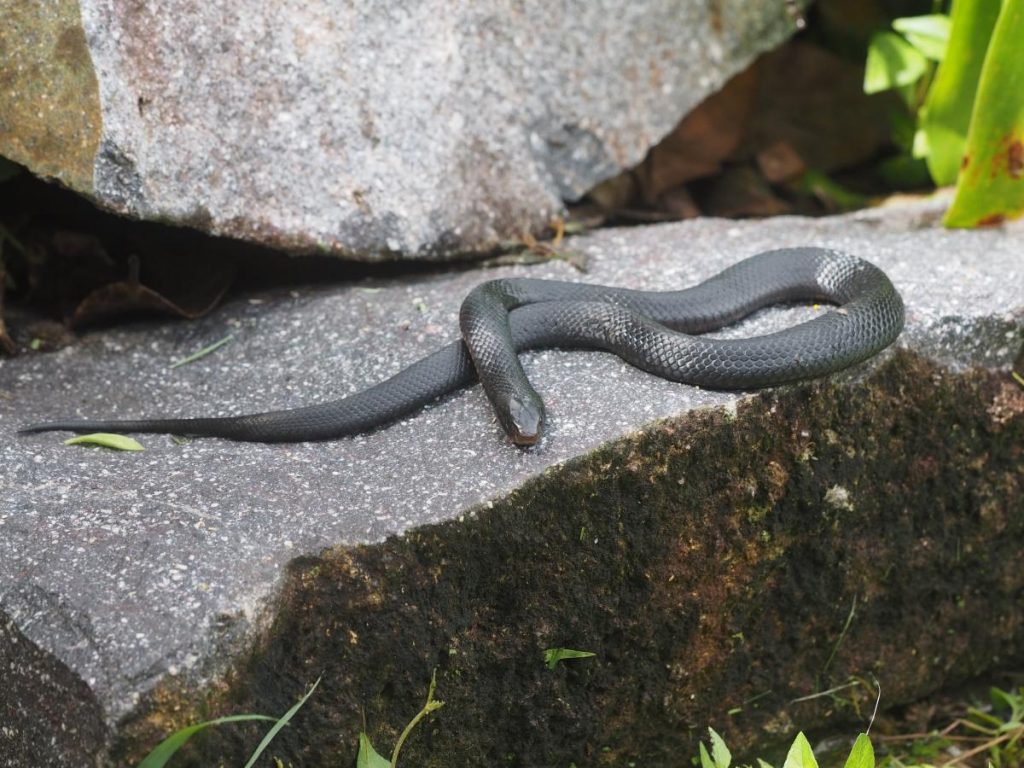
The red-bellied black snake is a member of the Elapidae Family – venomous snakes with fixed poison fangs at the front of the upper jaw. They occur mostly in the tropics, however the red-bellied black snake ranges through much of south-eastern Australia and up to the Atherton Tableland, inhabiting well-watered areas such as woodlands, swamps, creeks, river banks – and Paluma gardens. Its preferred diet is frogs and small lizards, but fish and small mammals may also be included on the menu. A handsome creature, growing to an average of 1.25 metres, the snake’s sleek, glossy black scales shimmer on the upper surface, while the underbelly can vary from a brilliant red to a pale, creamy pink.
Although the red-bellied black snake’s venom is capable of causing significant illness, fatalities in humans are rare, its bite being less venomous than other Australian elapids, such as the king brown snake or taipan. The venom contains neurotoxins, myotoxins, coagulants and has haemolytic properties. Fortunately, the red-bellied black snake is not an aggressive species and will move out of the way rather than face an unpleasant encounter. When provoked, it will assume a striking stance, hiss loudly and flatten the neck and body in a display that is mostly bluff.
That Flossie has not been bitten during the course of her many confrontations with black snakes is proof to me of their docile nature.
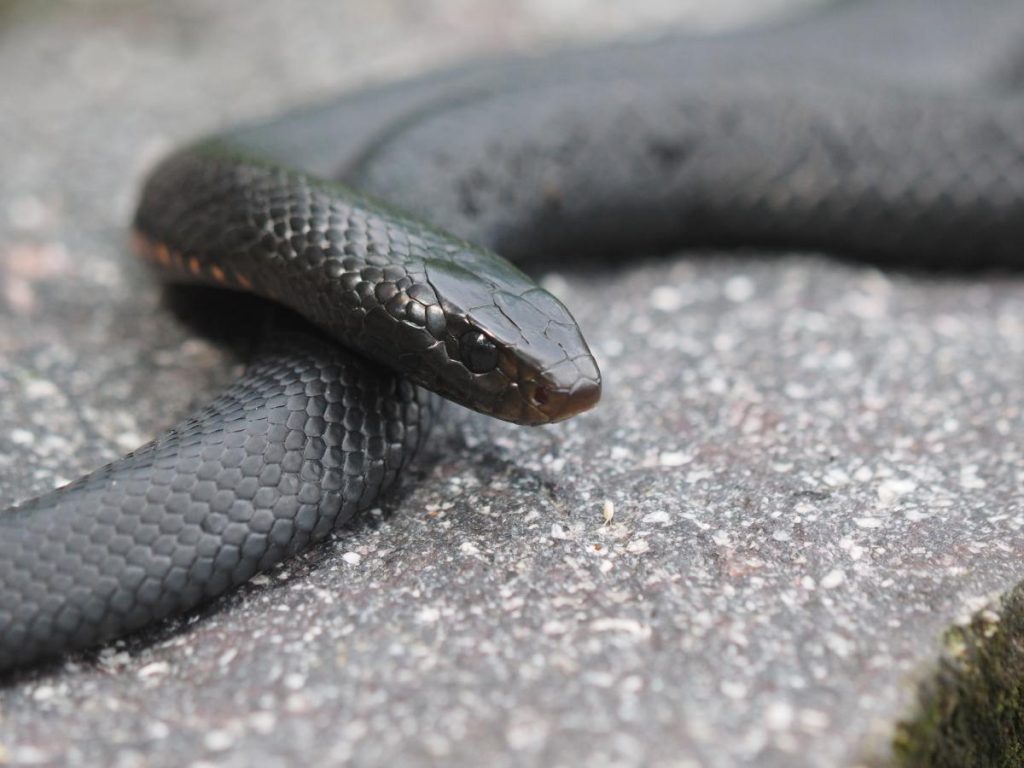
Snakes entered Australia millions of years ago from Asia, probably when the continental land masses were still joined. Two main groups of Elapids developed – one group comprised small nocturnal species with specialized feeding habits; and the other group, larger snakes, diurnal (active by day) and with more general diets. This group includes some of the deadliest snakes in the world: brown snakes, black snakes and taipans.
Live-bearing arose in two different lineages of Australian elapids. In one lineage, only a single species is viviparous: the common red-bellied black snake. It is alone among its closest relatives in bearing live young and because of this was able to expand the range of the genus into cooler, south-eastern parts of the country, whereas most egg-laying elapids such as taipans and king brown snakes, are found in warmer or tropical regions.
In bearing live young the female has the advantage of a shorter pregnancy. Eggs retained inside the mother’s body are kept warmer and develop faster than eggs laid in the earth, where in cold climates a low soil temperature impedes development of the embryo, even to the extent of preventing hatching before the arrival of the frosts of autumn. Live bearing benefits the young: enabling them to be born much earlier in the season, thus allowing them to feed and find shelter before the colder weather arrives. The baby snakes are born in a clutch of between ten and twenty, each encased in an amniotic sac from which they emerge within a few minutes ready to fend for themselves.
Black snakes like to maintain a body temperature close to 30 degrees Celsius. Many factors will determine how quickly a snake heats up: the intensity of solar radiation, wind, air temperature and the amount of the snake’s surface that is exposed to the sun. They can regulate their temperature by selecting a warm or cool position to lie, often by moving only a few centimetres, from lawn to beneath a shrub, for example. The snake can position its body so that only a small part is exposed but the warmed blood will carry heat to the rest of the body. If food is scarce, the snake benefits by being inactive and cool rather than expending energy and heat by hunting.
In spring, black snakes emerge and bask in the morning, heating up rapidly. They maintain their optimum body temperature all day even though the air temperature may drop below 20 degrees. In summer however, they generally do not bask, even if the morning is cool and their body temperature is quite low. Rather than heat up immediately they choose to remain cooler. Black snakes are actually cooler when the weather is hotter.
Pregnant females bask longer than non-pregnant females as warmth accelerates development of the embryos and is advantageous to both the mother and the young. An interesting observation is made by herpetologist Rick Shine (whose excellent book Australian Snakes: A Natural History, I have delved into for most of this information regarding black snakes). He describes the gathering together in summer of small groups, of two to six pregnant females when near to giving birth. They share a common night-time retreat, usually a burrow, and emerge together in the morning to bask. Female black snakes in late pregnancy do not feed so they remain in the vicinity of their burrow for weeks.
Although tending not to roam far from their own territory during the year, males in the spring mating season may travel up to 1 km in a day in search of a female. That is when you are most likely to come across one on the Paluma walking tracks!
Snakes have an undeservedly bad reputation, starting from the Biblical serpent who tempted Eve, to the wicked Mrs Black Snake who menaced Snugglepot and Cuddlepie. Other cultures have revered the snake and for many it was regarded as a symbol of knowledge and wisdom. Next time you come across a red-bellied black snake in your garden, pause and admire it for the beautiful and complex creature it is.
Article by Colwyn Campbell
References & More Information:
Rick Shine – Australian Snakes: A Natural History and Graeme Gow – Complete Guide to Australian Snakes.

(Image reproduced from Zoology and Botany of New Holland (1794) from an article on https://en.wikipedia.org/wiki/Red-bellied_black_snake).
Cancellation of Easter Markets
As a consequence of the closure of the upper Range Road to non-local traffic, the PDCA has decided that that Easter Sunday Markets will not be held this year. We regret having to make this decision and hope that the road will soon be fully open to all traffic.
Ecologica Exhibition
On Friday evening 5th April Lynn & Les Hyland visited the TYTO Gallery in Ingham for the opening of their new exhibition “Ecologica”, comprising works by three artists : Heather Byrne [Pastel] ; Linda Bates [Clay] and, from Paluma, Sarah Swan [Glass]. Sarah has had a table at the Paluma Markets and her lead-light work is really spectacular. She had a great many pieces on display, in particular, her “Seahorses” took this writer’s fancy.
Sarah owns 18 Mt Spec Rd, and, following the death of Roy Mackay, has also purchased 77 Mt Spec Rd. which she intends to transform into a gallery displaying her work. This she tells us, is a work already in progress.
The “Ecologica” exhibition is open until May 5th 2019 and if you can, do make an effort to see it – time very well spent. TYTO Gallery is open from 10.00 hrs to 16.00 hrs.

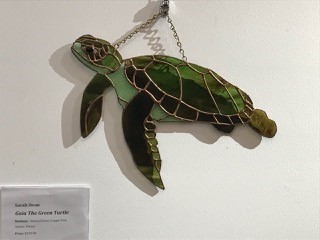
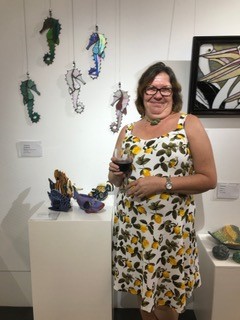
PDCA – Notice of Annual General Meeting
Members (and prospective members) are advised that the Annual General Meeting of the Paluma & District Community Association Inc. will be held on:
Saturday April 20th, 2019 at 5pm in the Community Hall
Nominations are open for all Executive Committee positions. Nominations should be forwarded to the Secretary to arrive no later than Wednesday 10th April 2019. Please use the nomination forms, which can be downloaded here.
Positions are:
- President,
- 1 or 2 Vice-Presidents
- Secretary
- Treasurer
- General Committee members (numbers flexible)
Members are reminded that Annual Subscriptions are now due and should be paid prior to the commencement of the AGM. Membership is available in two classes, these being Ordinary & Family. All classes attract the same subscription fee of $40.00 Please use the subscription form here to submit your dues. New members are more than welcome and should use the same form.
Please note that you must be a PDCA member to nominate someone to the Committee or vote for any Committee member.
The AGM will be followed immediately by a normal General Meeting with with the new Committee.
AGM AGENDA
- Opening – circulation of attendance sheet
- Apologies
- Minutes of previous AGM March 31, 2018
- President’s Report
- Treasurer’s report
- Election of Officers for 2019-2020
- Election of Auditor for 2019-2020
- Close of Annual General Meeting
Normal General Meeting Agenda
Normal General Meeting Agenda
- Open General Meeting
- Proposed Events/Fund-raising for the coming year
- Any other business
- Close of General Meeting
A celebration of Roy Mackay’s life.
Roy Mackay’s family can now confirm plans for the celebration of Roy’s long, full and incredibly rich life. This event will be held at the Paluma Village Hall from 2pm on Sunday 21st April, after the Easter market.
A barbecue and refreshments will be provided and further beverages will be available from the bar.
After the current period of grief and mourning that many of us are going through, this will be an opportunity to celebrate his life with love, happiness and respect.
We look forward to seeing all of you who knew Roy, who would like to join us and are able to do so.
Anyone who would like to say a few words about Roy will be able to after family members have done so. To assist with planning it would help (but isn’t essential) if those wishing to speak could let David Mackay know by email: kdavidmackay@gmail.com
Thank you.
Vale Roy Mackay – a message from the Mackay family
Roy David Mackay passed away peacefully in his sleep at Regis, Kirwan, on 12 February 2019.
Roy’s wishes were that there be no service at his cremation.
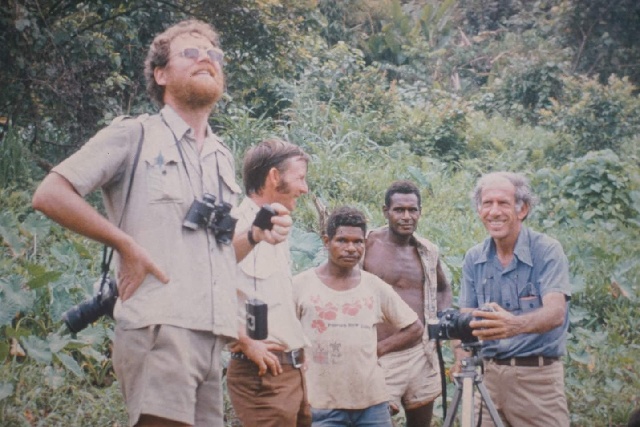
So that family and friends (from Paluma and elsewhere) can pay tribute to the incredible life that was his, an event celebrating his life is being planned for Paluma. Once arrangements have been finalised another notice will be posted on Paluma.org with the details.
The family would like to thank the Paluma community for their support of Roy, particularly in his twilight years, and to the family since his passing.
Kind regards,
David Mackay
